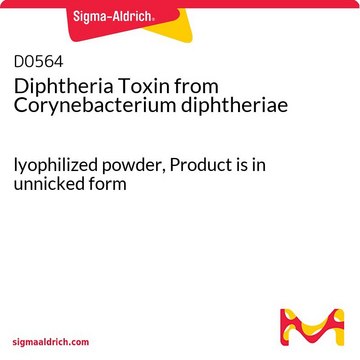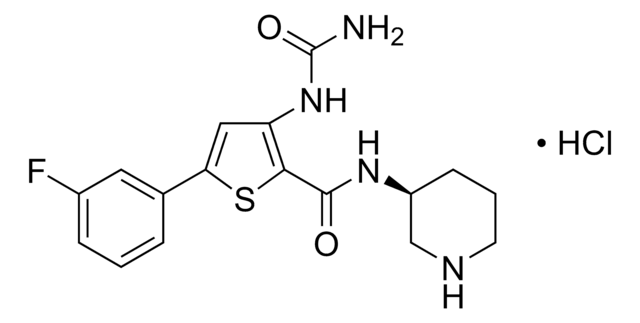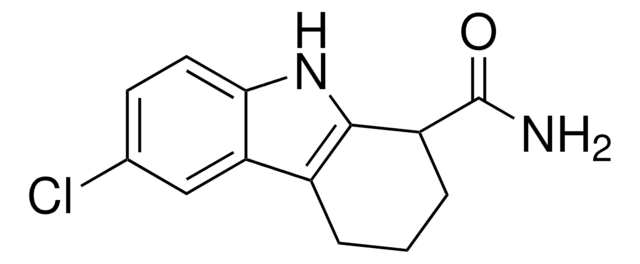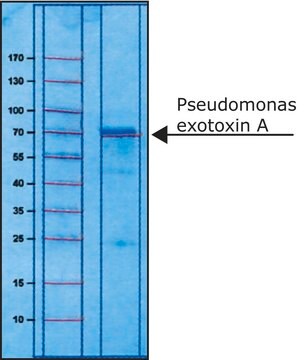推荐产品
产品名称
Diphtheria Toxin, Unnicked, Corynebacterium diphtheriae, Diphtheria toxin catalyzes ADP-ribosylation of eukaryotic aminoacyltransferase II (EF2) using NAD as substrate. Activation requires nicking with a protease followed by reduction with DTT.
品質等級
描述
RTECS - XW5807200
形狀
solid
製造商/商標名
Calbiochem®
儲存條件
OK to freeze
運輸包裝
ambient
儲存溫度
2-8°C
一般說明
Diphtheria Toxin, Unnicked, from Corynebacterium diphtheriae catalyzes ADP-ribosylation of eukaryotic aminoacyltransferase II (EF2) using NAD as substrate, thereby inhibiting protein synthesis. May also induce inter-nucleosomal breakdown. Causes DNA fragmentation and cytolysis in U937 cells. Activation requires nicking with a protease followed by reduction with DTT. Diphtheria toxin, synthesized and excreted as a proenzyme, is composed of a single polypeptide chain of 63 kDa. For its enzymatic activity to be expressed, the toxin must undergo two covalent alterations in structure. First, a mild proteolysis results in the formation of an enzymatically inactive "nicked toxin," which consists of two major fragments (A and B) linked by a disulfide bond. Reduction of the nicked toxin with thiols (DTT) releases the enzymatically active N-terminal A fragment (24 kDa). The C-terminal B fragment (39 kDa) has no apparent enzymatic activity. The B fragment is required for toxicity and is responsible for recognizing and binding of the toxin to cell surface receptors.
應用
Diphtheria Toxin, Unnicked, Corynebacterium diphtheriae has been used for intraperitoneal administration in mice for cell ablation.
生化/生理作用
Cell permeable: no
Note: Toxicity may vary by lot of toxin. Each laboratory should determine the optimum dosage for each particular application.
Primary Target
Eukaryotic aminoacyltransferase II (EF2)
Eukaryotic aminoacyltransferase II (EF2)
Product does not compete with ATP.
Reversible: no
警告
Toxicity: Harmful (C)
外觀
Lyophilized from sterile 10 mM Tris, 1 mM EDTA, pH 7.5.
重構
Following reconstitution, aliquot, quickly freeze on dry ice, and freeze (-70°C). Subsequent thawing should be carried out only at room temperature. For assays employing very low concentrations of diphtheria toxin, the use of a carrier protein, such as BSA or HSA, is recommended.
Please see vial label for lot-specific reconstitution volume.
分析報告
Major band (under reducing conditions) of ~63 kDa
其他說明
Diphtheria toxin is purified from Corynebacterium diphtheriae Park Williams strain 8 by a modified method of Pappenheimer, et al. As assessed by disc electrophoresis run at alkaline pH under non-denaturing conditions, this preparation migrates as a major band at 63 kDa, corresponding to the intact toxin. Two faster, more lightly stained bands (24 and 39 kDa), corresponding to A and B fragments, may be observed. Following trypsin treatment in DTT, diphtheria toxin exhibits high activity when assayed for its ability to ADP-ribosylate EF2. The ED50 for CHO cells is determined to be about 0.4 ng/ml.
Diphtheria toxin is purified from Corynebacterium diphtheriae Park Williams strain 8 by a modified method of Pappenheimer, et al. As assessed by disc electrophoresis run at alkaline pH under non-denaturing conditions, this preparation migrates as a major band at 63 kDa, corresponding to the intact toxin. Two faster, more lightly stained bands (24 and 39 kDa), corresponding to A and B fragments, may be observed. Following trypsin treatment in DTT, diphtheria toxin exhibits high activity when assayed for its ability to ADP-ribosylate EF2. The ED50 for CHO cells is determined to be about 0.4 ng/ml.
法律資訊
CALBIOCHEM is a registered trademark of Merck KGaA, Darmstadt, Germany
訊號詞
Danger
危險聲明
危險分類
Acute Tox. 1 Inhalation - Acute Tox. 1 Oral
儲存類別代碼
6.1A - Combustible acute toxic Cat. 1 and 2 / very toxic hazardous materials
水污染物質分類(WGK)
WGK 3
閃點(°F)
Not applicable
閃點(°C)
Not applicable
Tamar Licht et al.
The Journal of neuroscience : the official journal of the Society for Neuroscience, 40(5), 974-995 (2020-01-22)
Multiple insults to the brain lead to neuronal cell death, thus raising the question to what extent can lost neurons be replenished by adult neurogenesis. Here we focused on the hippocampus and especially the dentate gyrus (DG), a vulnerable brain
我们的科学家团队拥有各种研究领域经验,包括生命科学、材料科学、化学合成、色谱、分析及许多其他领域.
联系技术服务部门









